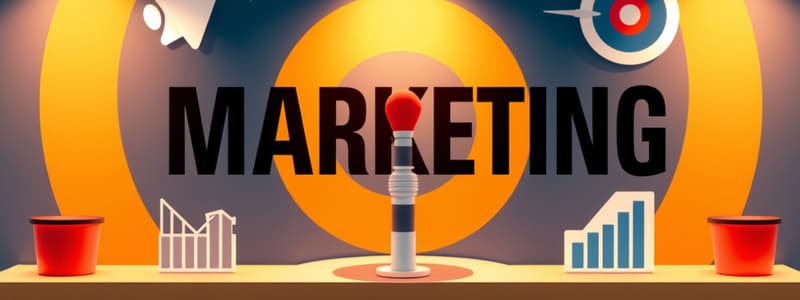Podcast
Questions and Answers
การวิจัยตลาดมีวัตถุประสงค์หลักเพื่ออะไร?
การวิจัยตลาดมีวัตถุประสงค์หลักเพื่ออะไร?
- เพื่อรวบรวมข้อมูลเกี่ยวกับความต้องการของผู้บริโภค (correct)
- เพื่อเพิ่มช่องทางการจำหน่าย
- เพื่อกำหนดราคาสินค้า
- เพื่อสร้างแบรนด์ให้มีชื่อเสียง
ส่วนผสมทางการตลาด 4 Ps ประกอบด้วยอะไรบ้าง?
ส่วนผสมทางการตลาด 4 Ps ประกอบด้วยอะไรบ้าง?
- ผลิตภัณฑ์, ราคา, บริการ, โปรโมชั่น
- ผลิตภัณฑ์, ราคา, สถานที่, โปรโมชั่น (correct)
- ผลิตภัณฑ์, บัญชี, สถานที่, โปรโมชั่น
- ราคา, แบรนด์, สถานที่, โปรโมชั่น
การตลาดดิจิทัลมีลักษณะเด่นอย่างไร?
การตลาดดิจิทัลมีลักษณะเด่นอย่างไร?
- การใช้แพลตฟอร์มออนไลน์เพื่อเข้าถึงผู้บริโภค (correct)
- การสร้างเนื้อหาที่มีค่าเพื่อดึงดูดผู้คน
- การทำให้สินค้าตรงตามความต้องการของผู้บริโภค
- การพัฒนาผลิตภัณฑ์ใหม่ทั้งหมด
การวิเคราะห์พฤติกรรมผู้บริโภคมีเป้าหมายเพื่ออะไร?
การวิเคราะห์พฤติกรรมผู้บริโภคมีเป้าหมายเพื่ออะไร?
แนวโน้มด้านความยั่งยืนในตลาดหมายถึงอะไร?
แนวโน้มด้านความยั่งยืนในตลาดหมายถึงอะไร?
การตลาดเชิงเนื้อหาเกี่ยวข้องกับอะไร?
การตลาดเชิงเนื้อหาเกี่ยวข้องกับอะไร?
การใช้ KPI ในการตลาดมีข้อดีอย่างไร?
การใช้ KPI ในการตลาดมีข้อดีอย่างไร?
การแบ่งกลุ่มตลาดสามารถทำได้จากปัจจัยใดบ้าง?
การแบ่งกลุ่มตลาดสามารถทำได้จากปัจจัยใดบ้าง?
Flashcards are hidden until you start studying
Study Notes
MKT (Marketing)
Definition
- Marketing is the process of promoting, selling, and distributing a product or service.
Key Concepts
-
Market Research
- Gathering data about consumers' needs and preferences.
- Methods include surveys, focus groups, and analysis of market trends.
-
Target Market
- A specific group of consumers aimed at with marketing efforts.
- Segmentation can be based on demographics, psychographics, geography, and behavior.
-
Marketing Mix (4 Ps)
- Product: What is being sold, including features, design, and quality.
- Price: The cost consumers pay, influenced by competition, perceived value, and cost of production.
- Place: Distribution channels used to deliver the product to consumers.
- Promotion: Strategies to inform and persuade customers, including advertising, public relations, and sales promotions.
Strategies
- Digital Marketing: Utilizing online platforms (social media, email, websites) to reach consumers.
- Content Marketing: Creating valuable content to attract and engage an audience.
- Branding: Developing a strong, positive perception of a company or product in consumers' minds.
Consumer Behavior
- Understanding how consumers make purchasing decisions.
- Factors influencing behavior include cultural, social, personal, and psychological aspects.
Trends
- Sustainability: Growing consumer preference for eco-friendly products.
- Personalization: Tailoring marketing messages and offerings to individual preferences.
- Influencer Marketing: Collaborating with individuals who have a significant following to promote products.
Evaluation
- Key Performance Indicators (KPIs): Metrics to assess the effectiveness of marketing campaigns (e.g., sales growth, website traffic, engagement rates).
Conclusion
- Marketing is essential for connecting businesses with consumers and driving sales. Understanding its core components and current trends can lead to more effective strategies.
ข้อมูลทั่วไปเกี่ยวกับการตลาด
- การตลาดคือกระบวนการในการส่งเสริม ขาย และจัดจำหน่ายผลิตภัณฑ์หรือบริการ
แนวคิดหลัก
- การวิจัยตลาด:
- เก็บข้อมูลเกี่ยวกับความต้องการและความชอบของผู้บริโภค
- วิธีการรวมถึงการสำรวจ กลุ่มสนทนา และการวิเคราะห์แนวโน้มตลาด
- กลุ่มเป้าหมาย:
- กลุ่มผู้บริโภคเฉพาะที่มุ่งหวังจะเข้าถึงผ่านกิจกรรมการตลาด
- การแบ่งกลุ่มสามารถทำได้ตามข้อมูลประชากร จิตวิทยา ภูมิศาสตร์ และพฤติกรรม
- ส่วนผสมการตลาด (4Ps):
- ผลิตภัณฑ์: สิ่งที่ถูกขาย รวมถึงคุณสมบัติ การออกแบบ และคุณภาพ
- ราคา: ต้นทุนที่ผู้บริโภคต้องจ่าย ซึ่งได้รับอิทธิพลจากการแข่งขัน คุณค่าในสายตา และต้นทุนการผลิต
- สถานที่: ช่องทางการจัดจำหน่ายที่ใช้ในการนำผลิตภัณฑ์ส่งถึงผู้บริโภค
- การส่งเสริม: กลยุทธ์เพื่อให้ข้อมูลและชักชวนลูกค้า รวมถึงโฆษณา สื่อสารสาธารณะ และการส่งเสริมการขาย
กลยุทธ์
- การตลาดดิจิทัล:
- ใช้แพลตฟอร์มออนไลน์ (โซเชียลมีเดีย อีเมล เว็บไซต์) เพื่อเข้าถึงผู้บริโภค
- การตลาดเนื้อหา:
- สร้างเนื้อหาที่มีคุณค่าเพื่อดึงดูดและมีส่วนร่วมกับผู้ชม
- แบรนดิ้ง:
- การพัฒนาการรับรู้ที่แข็งแกร่งและเป็นบวกเกี่ยวกับบริษัทหรือผลิตภัณฑ์ในใจของผู้บริโภค
พฤติกรรมผู้บริโภค
- ทำความเข้าใจว่าเหตุใดผู้บริโภคจึงทำการตัดสินใจการซื้อ
- ปัจจัยที่มีผลกระทบประกอบด้วยด้านวัฒนธรรม สังคม ส่วนตัว และจิตวิทยา
เทรนด์ล่าสุด
- ความยั่งยืน:
- ความชอบที่เพิ่มขึ้นของผู้บริโภคต่อผลิตภัณฑ์ที่เป็นมิตรกับสิ่งแวดล้อม
- การปรับแต่ง:
- การปรับแต่งข้อความการตลาดและข้อเสนอให้ตรงกับความชอบของแต่ละบุคคล
- การตลาดผ่านผู้มีอิทธิพล:
- การร่วมมือกับบุคคลที่มีผู้ติดตามมากเพื่อส่งเสริมผลิตภัณฑ์
การประเมินผล
- ตัวชี้วัดประสิทธิภาพหลัก (KPIs):
- เมetrice ในการประเมินความมีประสิทธิภาพของแคมเปญการตลาด เช่น การเติบโตของยอดขาย การเข้าชมเว็บไซต์ และอัตราการมีส่วนร่วม
สรุป
- การตลาดมีความสำคัญต่อการเชื่อมโยงธุรกิจกับผู้บริโภคและกระตุ้นยอดขาย การเข้าใจส่วนประกอบหลักและแนวโน้มในปัจจุบันสามารถนำไปสู่วิธีการที่มีประสิทธิภาพมากขึ้น
Studying That Suits You
Use AI to generate personalized quizzes and flashcards to suit your learning preferences.




